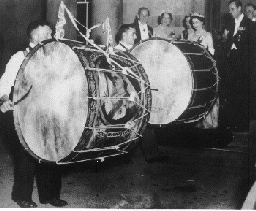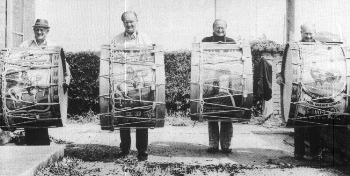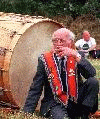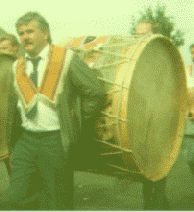
The Tradition of the Lambeg Drum
By BILLY KENNEDY
The Lambeg Drum rivals the flute as the most traditionalof Orange instruments. but its exact origin is open to
debate.
Folklore has it that the Lambeg drum was brought to
Ireland from Holland by troops of Duke Schomberg,
William's second-in-command at the Boyne. Another
theory is that the first Lambeg drum was made for the Battle
of the Diamond in September 1795, after which the Orange
Order was formed.
Sandy Row drum maker William Hewitt claims his
grandfather made the first Lambeg drum in 1870 and it had
its first appearance at a Twelfth demonstration in Lambeg
the following year.
This drum measured 86 centimetres in diameter and
61 centimetres in width, and is still in the possession of a
Moira, Co. Down lodge.
However, there are drums which pre-date the 1870
version - one in Belfast is marked with the name Walsh
the drum maker and dated 1849, the year of the Battle of
Dolly's Brae.
It measures 72 centimetres in diameter and 61
centimetres in width and resembles present-day Lambeg
drums, with a construction of two oak boards.
William did stop at Lambeg outside Lisburn on his way
to the Boyne in 1690, and this could probably explain the
name given to the large drums which have become such a
dominant feature of Orange parades over the past ~50 years.
Various animal skins have been used for the drum
heads. but today the goatskin is the most popular. The shell
is mostlv of wood, but brass has been used. Drum sticks
are of wooden cane.

The beating of drums has been associated with Orange
processions since the formation of the Order in 1795. A
drum was carried at a Twelfth demonstration in Co. Armagh
in 1796, lord Gosford, of Markethill, confirms in a letter
to the Lord Lieutenant. Lord Camden in Dublin Castle.
"I have the honour to acquaint your excellency that the
meeting of Orangemen took place in different parts of this
county. One party, consisting Of 30 companies with banners
etc'., after parading through Portadown, Loughgall, and
Richhill came towards this place. the party had one drum
and each company had a fife and two or three men in front
with painted wands in their hands who acted as
commanders."
The 1796 version was probably the first of the fife and
drum combinations that were to become a celebrated part
of Orange culture.
Before the dramatic increase in bands by the early half
of this centurv. the accompaniment of Orange lodges by
drummers and fifers was a regular feature of parades.
Lambeg drummers beat to a set rhythm or roll whether
it he tune with another drum or a fife. The sound of the
drum travels horizontallv and with the shrill tones of the
fife moving in a vertical direction the two blend in quite a
unique way.

Armagh, not surprisingly, has the strongest tradition
of Lambeg drumming of any county in Northern Ireland.
Travel the roads of Tandragee, Lurgan or Loughgall
any evening leading up to the Twelfth and you are nearly
bound to hear the staccato heat sounding out from a fully
tightened drum over the summer night air.
Even prominent politicians like Jack Maginnis and the
late Harold MeCusker loved a crack with the cane on the
goatskins that made up the head of a Lambeg drum.
But the advent of more bands on the scene has meant
a reduction in the number of drums being carried at Twelfth
parades. And even the traditionalists in Co. Armagh will
admit that the place for Lambeg drums in the Twelfth walk
is narrowing.
In the heyday of drumming - back in the thirties and
forties - the 22 lodges of Tandragee Orange district usually
had about 60 drums out on a Twelfth parade. Loughgall,
Portadown. and Lurgan districts were the same and it was
commonplace for 200 drums to be carried at the county
demonstration with some of the drums being accomp:tnied
bv a fifer,
Now the quota of drums taking part has been reduced
to around 50 overall, most of them taken only by the
Tandragee. Loughgall, Lurgan and Portadown Orangemen.
Getting drummers is also another problem for the
lodges and sometimes it is left to a few enthusiasts in the
number to look after the drums for the day.
Most of the Co. Armagh drums, as elsewhere in the
Province. are now owned bv individual members of a lodge
and this allows greater freedom to participate in the many
drumming matches that are held throughout Ulster from
Februarv to November each year.
New drums can still be purchased from William Hewitt
in Sandy Row at a cost of about £100 but there are also
drum-makers in Carrickfergus and Tandragee. Some
in centres from Co. Armagh to South Derry and South
Antrim.
The weather is a factor in getting the best out of a drum
and a summer heatwave was considered to be ideal. The
warmer and drier it is the sweeter the tune. Wet weather
spoils a good drum. There are no tunes as such in a Lambeg
drum but each drummer has his own distinct rhythm and roll.
You will not hear a Lam beg drum at the Twelfth parade
enthusiasts make their own heads and these cost anything
from £30 to £40.
The drumming matches are organised by three different
associations, the largest operating from Glenavy and
carrying a Province-wide membership. The other two are
in Mid-Ulster and in the Tandragee area.
In addition to cups the prizes at drumming matches can
include cash incentives for the winner.
It has now become largely a sport and 30-60 drums
usually take part in the matches that are held every week-end
in Belfast - drumming has practically died out in the city.
But in most of the provincial centres, notably Co. Armagh,
you will, even if the drums are fewer in number than they
were in the halcyon days of the fifer.
Only a few traditional fifers remain - in the South
Down and South Antrim areas. Unlike the drummers theirs
is a dying art.
For Orangemen, the Twelfth would not be the same
without a rattle or two on a Lambeg Drum.
 -Imagine!
6-8 of these in a line walking and playing! Much more than a rattle -Thanks
Norman Nelson for the photo and description! Perhaps we shall see the two
great war drums of the Island playing side by side together! The Bodhran
is after all a war drum too! (But the Lambeg is a bodhran on steroids!!!)
-Imagine!
6-8 of these in a line walking and playing! Much more than a rattle -Thanks
Norman Nelson for the photo and description! Perhaps we shall see the two
great war drums of the Island playing side by side together! The Bodhran
is after all a war drum too! (But the Lambeg is a bodhran on steroids!!!)